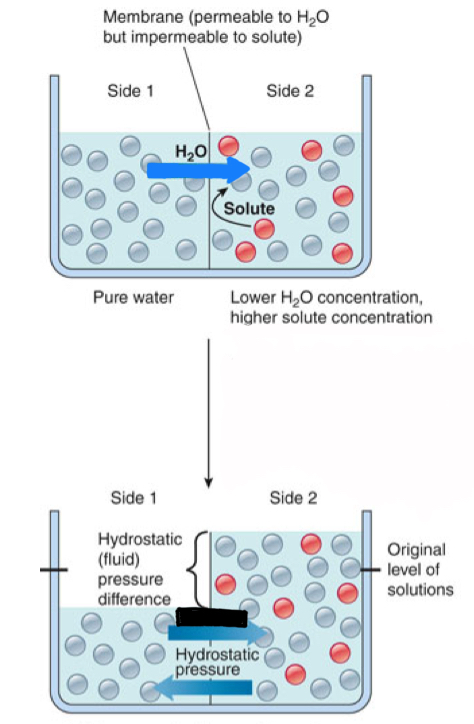Practical Human Physiology
1/262
Earn XP
Name | Mastery | Learn | Test | Matching | Spaced |
|---|
No study sessions yet.
263 Terms
What is the plasma membrane’s structure?
fluid lipid bilayer embedded with proteins
most abundant lipids = phospholipids
small amount of carbohydrates → on surface only
role of selfness = blood
negative → doesn’t have carbs
positive → has carbs
cholesterol → tucked btw phospholipid molecules
contributes to fluidity and stability of cell membrane = breaks rigidness of membrane
precursor for hormones → testosterone, estrogen
Function of plasma membrane proteins:
span membrane to form water-filled pathways, or channels across lipid bilayer
serves as carrier molecules and docking-marker acceptors
membrane-bound enzymes
receptor sites
cell adhesion molecules (CAMs)
proteins on surface are important in cells’ ability to recognize “self” and in cell-to-cell
Functions of the lipid bilayer of the plasma membrane:
forms basic structure of the membrane
hydrophilic interior serves as barrier to passage of water soluble substances between ICF and ECF
responsible for fluidity of the membrane
Function of membrane carbohydrates:
serve as self-identity markers which enable cells to identify and interact with one another
different cell types have different markers
carbohydrate-containing surface markers are also involved in tissue growth
What are the levels of organization?
Chemical
Cellular
Tissue
Organ
Body System
Organism
The “chemical” level of organization is…
molecules composed of atoms
The “cellular” level of organization is…
cells are basic unit of life
Senses and responds to changes in its environment
The “tissue” level of organization is…
four primary types of tissues
What are the four primary types of tissues?
Muscle
Epithelial
Nervous
Connective
What is muscle tissue?
Produces protection and movement through contraction of muscle fibers
Give three examples of muscle tissue..
Skeletal: attaches to the bone & provides movement of the body
Cardiac: only in heart & causes it to beat
Visceral/Smooth: in the walls of the internal organs
What is epithelial tissue?
Covers the surface of the bod and is the main tissue of the skin —> secrete and protection
Give examples of epithelial tissues..
skin
intestinal, respiratory, urinary, and circulatory tract
In the lining of blood vessels and body cavities
Forms the glands of the Exo/Endocrine system
What is nervous tissue?
Coordinates and controls all bodily activities by transmitting messages throughout the body
Give examples of nervous tissue…
brain
nerves
spinal cord
What is connective tissue?
Supports and connects organs and body tissues
Give examples of connective tissue…
adipose —> fat
fibrous —> tendons, ligaments
cartilage —> smooth, elastic
bone —> hard, unbendable
blood —> liquid/vascular
The “organ” level of organization is…
consists of two or more types of tissues
The “body system” level of organization is…
groups of organs that perform related functions
How many body systems are there and what are they?
circulatory system
digestive system
respiratory system
urinary system
skeletal system
muscular system
integumentary system
immune system
nervous system
endocrine system
reproductive system
lymphatic system
When you think about these 11-12 physiological systems, what is the common “denominator” that ties them together, so they are in various ways dependent on each other?
Homeostasis
What is homeostasis?
A maintenance of a relatively stable internal environment
each cell contributes
essential for survival and function of all cells
What is extracellular fluid (ECF)?
It is a fluid environment in which the cells live
outside of the cells
What are the two components of extracellular fluid?
plasma/blood
interstitial fluid
What is intracellular fluid (ICF)?
Fluid contained within all body cells
What factors are homeostatically regulated?
concentration of nutrient molecules
concentration of O2 and CO2
concentration of waste products
pH
concentration of water, salt, and other electrolytes
volume and pressure
temperature
What is the role of the circulatory system?
It carries materials from one part of the body to another
What is the role of the digestive system?
breaks down dietary food into smaller molecules that can be distributed to body cells
transfers water and electrolytes from external environment to internal environment
eliminates undigested food residues to external environment in the feces
What is the role of the respiratory system?
gets O2 from and eliminates CO2 to the external environment
important in maintenance of proper pH of internal environment
What is the role of the urinary system?
removes excess water, salt, acid, and other electrolytes from plasma and eliminates them in urine
Thanksgiving —> have to pee a lot
What is the role of the skeletal system?
provides support and protection for soft tissues and organs
serves as storage reservoir for calcium
along with muscular system enables movement of body and its parts
bone marrow is ultimate source of all blood cells
What is the role of the muscular system?
moves the bones
What is the role of the integumentary system?
serves as our protective barrier
important in regulating body temperature
What is the role of the immune system?
defends against foreign invaders and against body cells that have become cancerous
paves way for repairing or replacing injured or worn-out cells
What is the role of the nervous system?
controls and coordinates bodily activities that require rapid responses
detects and initiates reactions to changes in external environment
What is the role of the endocrine system?
secreting glands of endocrine regulate activities that require duration rather than speed
controls concentration of nutrients and, by adjusting kidney function, controls internal environment’s volume and electrolyte composition
What is the role of the reproductive system?
not essential for homeostasis (not essential for survival of individual)
is essential for perpetuating the species
In order to maintain homeostasis, we need to be able to…
detect deviations from normal in the internal environment that need to be held within narrow limits
integrate this information with other relevant information
make appropriate adjustments in order to restore factor to its desired value
What are the two classes of control systems?
Intrinsic controls
Extrinsic controls
What are intrinsic controls?
local controls that are inherent in an organ
What are extrinsic controls?
regulatory mechanisms initiated outside an organ
accomplished by nervous and endocrine systems
What is a feedforward system?
term used for responses made in anticipation of a change
hormonal influences to generate a response
Example of feedforward systems?
hunger pains (ghrenlin) —> start looking for food
What is a feedback system?
refers to responses made after change has been detected
What are the types of feedback systems?
negative - exerts a response to oppose/decrease
positive - exerts a response to amplify
What is a negative feedback system?
primary type of homeostatic control
opposes initial change
components:
sensor: monitors magnitude of a controlled variable
control center: compares sensor’s input with a set point
effector: makes a response to produce a desired effect
What is a positive feedback system?
amplifies an initial change
does not occur as often as a negative feedback system
Example:
uterine contractions become increasingly stronger until the birth of the baby
Disruptions in homeostasis can lead to…
illness
death
pathophysiology: abnormal functioning of the body associated with disease
What is the plasma membrane?
AKA cell membrane
surrounds every cell → thin layer of lipids and protein that forms outer boundary
separates cell contents from its surroundings
separates ICF and ECF
controls movement of molecules between the cell and the environment
participates in joining cells to form tissues and organs
important role in the ability of a cell to respond to changes in the cell’s environment
What is the nucleus?
typically the largest single organized cell component
enclosed by a double-layered nuclear envelope
contains cell’s genetic material, DNA
What are the DNA functions?
directs protein synthesis
serves as genetic blueprint during cell replication
What is the cytoplasm?
portion of cell interior not occupied by the nucleus
consists of
organelles
cytoskeleton
What are organelles?
“little organs”
distinct, highly organized, membrane-enclosed structures
What is the cytoskeleton?
complex protein network protein of cytosol
found in a complex, gel-like liquid called the cytosol
“bone and muscle” of the cell
Has three distinct elements:
microtubules
microfilaments
intermediate filaments
What is the cytosol?
occupies about 55% of total cell volume
semi-liquid portion of cytoplasm that surrounds the organelles
contains cytoskeleton
What activities do the cytosol participate in associated with gelatinous portion of cytoplasm?
enzymatic regulation of intermediary metabolism
ribosomal protein synthesis
perform what is necessary within the cell —> free ribosome
storage of fat, carbohydrate, and secretory vesicles
What is the endoplasmic reticulum (ER)?
elaborate fluid-filled membranous system distributed throughout the cytosol
Primary function -> protein and lipid manufacture
Two types:
smooth ER
rough ER
What is the smooth ER?
lipid synthesis
mesh of tiny interconnected tubules
What is the rough ER?
protein synthesis
projects outward from smooth ER as stacks of relatively flattened sacs
surface has attached ribosomes, but free ribosomes can sometimes go through rough ER depending on signaling
What is the golgi complex?
closely associated with the ER
consists of cisternae
number of golgi complexes per cell varies with the cell type
AKA the post office
What are the functions of the golgi complex?
processes raw materials into finished products
sorts and directs finished products to their final destinations
packages secretory vesicles to release by exocytosis
What are cisternae?
It is a stack of flattened, slightly curved, membrane-enclosed sacs
like pancake stack
What is a lysosome?
membranous sacs containing hydrolytic enzymes
serve as intracellular digestive system
Extracellular material attacked by lysosomes enters cell by endocytosis
What is endocytosis?
the process of actively transporting molecules into the cell by engulfing it with its membrane
What are they kinds of endocytosis?
pinocytosis
receptor-mediated endocytosis
phagocytosis
What is pinocytosis?
A kind of endocytosis where you are taking in fluid; very small
What is receptor-mediated endocytosis?
receptor based endocytosis, which means it is more specific
What is phagocytosis?
type of endocytosis where you are engulfing something large
What are peroxisomes?
membranous sacs that house oxidative enzymes that detoxify various waste products
waste products = alcohol
Examples of things with a lot of peroxisomes?
Liver: fibrous tissue does not equal a lot of peroxisomes
Potatoes: lots of peroxisomes
potatoes stay good because of a lot of starch
What is the mitochondria?
energy organelle
major site of ATP production
contains enzymes for citric acid cycle and electron transport chain
enclosed by a double membrane
cristae
What is the cristae?
It is the inner infolded membrane of the mitochondria
Would the mitochondria be different in a superhero?
there would be an increased number of mitochondria
What are the steps involved in generation of ATP within the cell?
Glycolysis
Citric Acid Cycle (Kreb Cycle)
Electron Transport Chain
What is glycolysis?
chemical process involving 10 separate sequential reactions that break down glucose into two pyruvic acid molecules
anaerobic process
What is the citric acid cycle?
requires oxygen
pyruvic acid from glycolysis is converted to acetyl CoA which enters citric acid cycle
citric acid cycle consists of eight separate biochemical reactions that are directed by enzymes of mitochondrial matrix
important in preparing hydrogen carrier molecules for entry into electron transport system
What is the electron transport chain?
requires oxygen
series of reactions that occur on the inner mitochondrial membrane
major source of ATP needed for cellular activities
What cellular activities that require ATP?
synthesis of new chemical compounds
membrane transport
mechanical work
repair of cells/tissues in a superhero
Breaking a chemical bond is…
an energy source in proteins
Athletes can remove lactatic acid, more or less efficiently?
More efficiently because of their training
What differences does a superhero have?
stress → stress on cells and stress response
speed of cellular response
fitness training
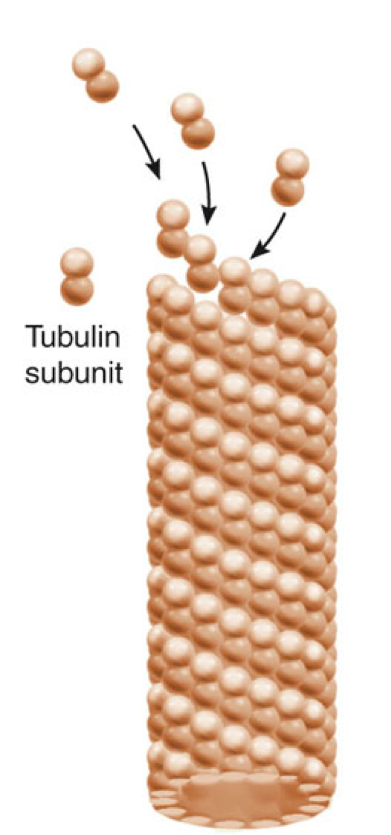
What are microtubules?
AKA freeway
transport secretory vesicles
movement of specialized cell projections
form mitotic spindle during cell division
contain tubulin protein
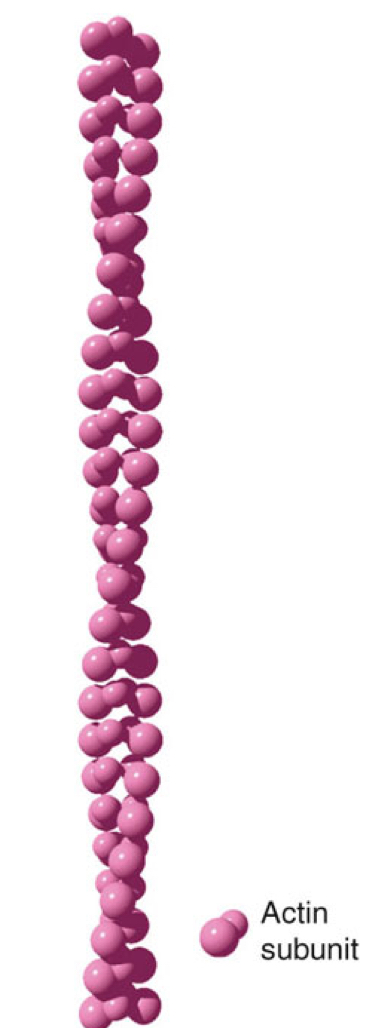
What are microfilaments?
contractile systems
mechanical stiffeners
gives strength
contain 2 chains of actin protein
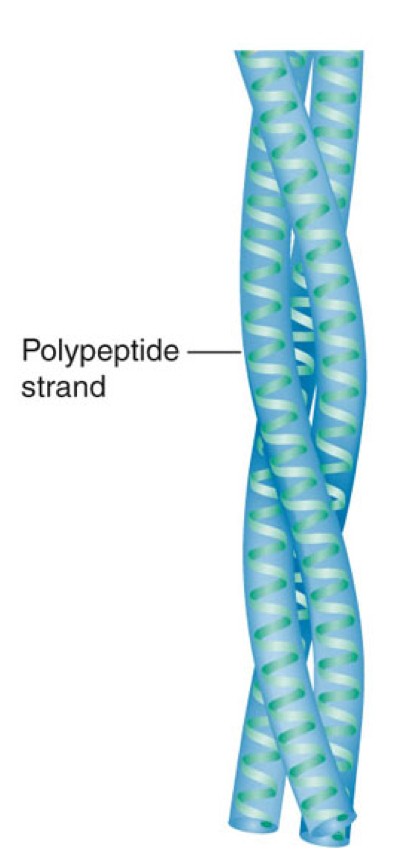
What are intermediate filaments?
help resist mechanical stress → cannot pull off our skin
gives strength
contains keratin
What are cell-to-cell adhesions?
Adhesions bind groups of cells into tissues and package them into organs
Once arranged, cells are held together by three different means
Extracellular matrix
Cell adhesion molecules in cells’ plasma membranes
specialized cell junctions
What is the extracellular matrix?
AKA biological glue
major types of protein fibers interwoven in matrix
collagen, elastin, & fibronectin
What are the three types of specialized cell junctions?
Desmosomes
Tight junctions → impermeable junctions
Gap junctions → communicating junctions
What are desmosomes?
A kind of specialized cell junction that doesn’t come apart easily
act like “spot rivets” that anchor two closely adjacent non-touching cells
most abundant in tissues that are subject to considerable stretching

What are tight junctions?
Firmly bond adjacent cells together → like sewing
seal off the passageway between the two cells
found primarily in sheets of epithelial tissue
prevent undesirable leaks within epithelial sheets
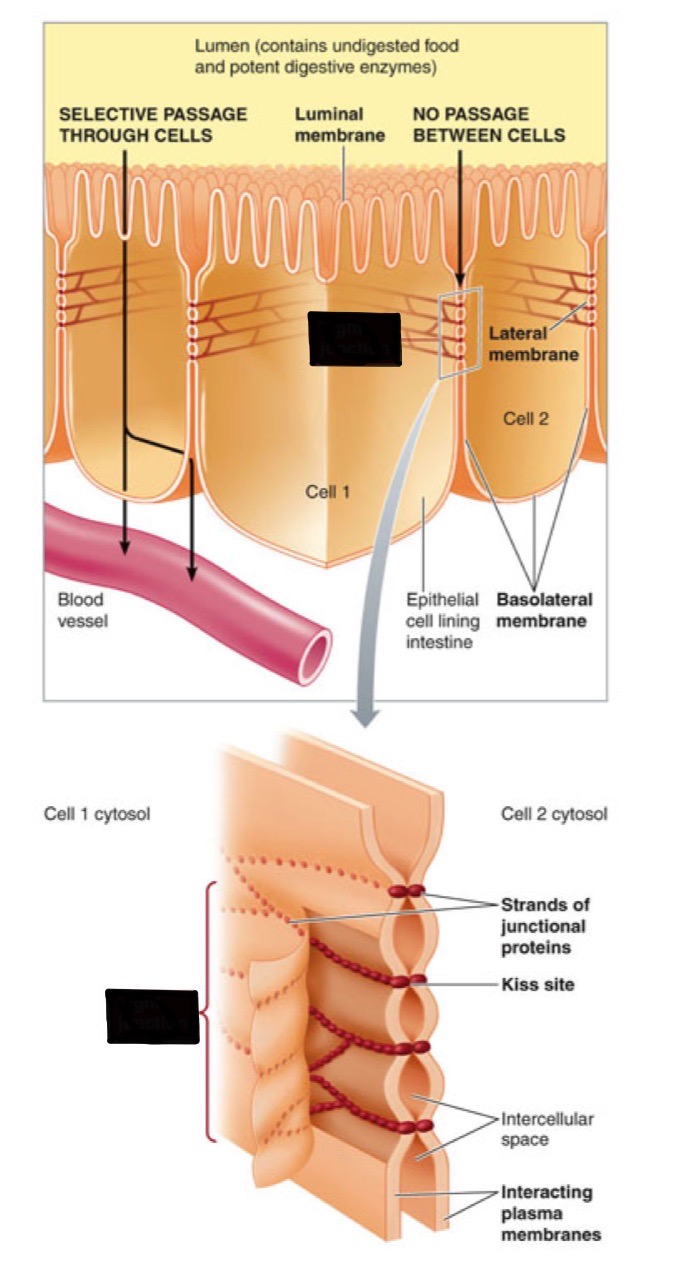
Example(s) of tight junctions:
Bladder → urine doesn’t leak
Digestive system → acid doesn’t spill
What are gap junctions?
small connecting tunnels formed by connexons
especially abundant in cardiac and smooth muscle
in non-muscle tissues permit unrestricted passage of small nutrient molecules between cells
serve as method for direct transfer of small signaling molecules from one cell to the next
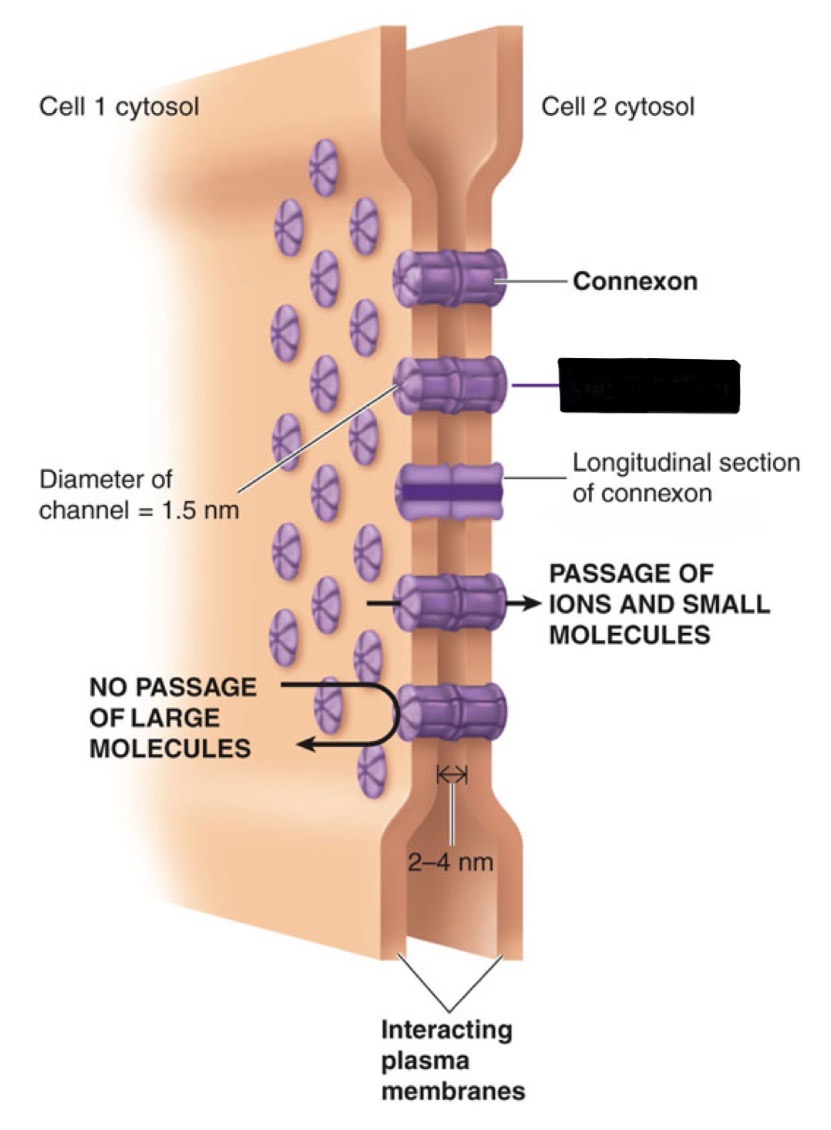
Example(s) of gap junction:
Uterine contactions
What is membrane transport?
cell membrane is selectively permeable
two properties of particles influence whether they can permeate cell membrane without assistance
relative solubility of particle in liquid
size of particle
What are the kinds of membrane transport?
Unassisted membrane transport
diffusion
osmosis
Assisted membrane transport
carrier-mediated transport
facilitated transport
active transport
vesicular transport
What is diffusion (simple passive diffusion)?
uniform spreading out of molecules due to their random intermingling
molecules move from area of high concentration to area of low transport
process is crucial to survival of every cell
simple passive diffusion → no energy required
doesn’t require membrane
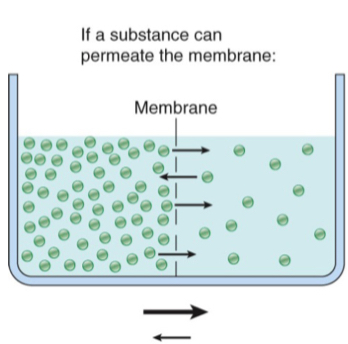
Diffusion plays an important role in what processes?
exchange of oxygen and carbon dioxide between blood and air in lungs
movement of substances across kidney tubules
Diffusion example outside of body system:
Sugar in coffee
Simple diffusion is
movement of ions from hyper to hypo
What are the factors affecting rate of diffusion in Fick’s law of diffusion?
Magnitude/steepness of the concentration gradient
Permeability of the membrane to the substance
Surface area of the membrane across which diffusion is taking place → more surface area doesn’t = increased efficiency
Molecular weight of the substance → high weight = more energy required
Distance through which diffusion takes place
What is osmosis?
net diffusion of water down its own concentration gradient
requires membrane
energy independent → passive process
Tonicity of solution
